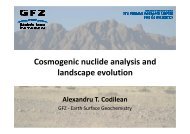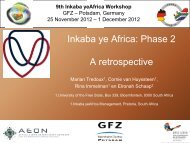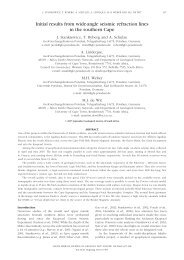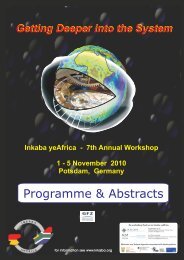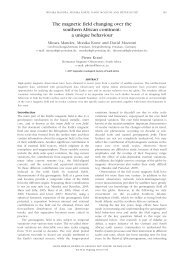South Africa - Inkaba.org
South Africa - Inkaba.org
South Africa - Inkaba.org
Create successful ePaper yourself
Turn your PDF publications into a flip-book with our unique Google optimized e-Paper software.
Records of Late Quaternary environmental changes<br />
preserved in eolian and fluvial sediment geoarchives<br />
of the SW-Kalahari, <strong>South</strong> <strong>Africa</strong><br />
J. Völkel 1 , K. Hürkamp 1 , K. Heine 2 , O. Bens 3 , M. Leopold 1 , J. Winkelbauer 1<br />
1. Technische Universität München, Department of Geomorphology and Soil Science,<br />
85350 Freising - Weihenstephan, Germany, geo@wzw.tum.de<br />
2. University of Regensburg, 93040 Regensburg, Germany, klaus.heine@geographie.uni-regensburg.de<br />
3. Helmholtz Centre Potsdam, GFZ German Research Centre for Geosciences,<br />
14473 Potsdam, Germany, oliver.bens@gfz-potsdam.de<br />
ABSTRACT<br />
Precipitation in southern <strong>Africa</strong> – tropical summer rains in the north and the east and extratropical winter rains in<br />
the southwest – is strongly influenced by the seasonal shift of the Intertropical Convergence Zone (ITCZ). Little is<br />
known so far about the displacement since the Last Glacial Maximum (LGM; ~22-18 ka BP). Geomorphological<br />
and sedimentological field work and laboratory analyses were carried out on fluvial, colluvial and eolian<br />
geoarchives (valley, pan and terrestrial slope sediments, as well as dunes) in the catchment of the southern lower<br />
Molopo River within the southwest Kalahari and were paleoclimatically interpreted. This area is very suitable for<br />
terrestrial research on paleoclimatic and environmental change. Here dunes and pans coexist as major Kalahari<br />
geomorphological types in an ideal way with the Molopo River valley, including different fluvial sediment facies<br />
interbedded with slope and eolian sediments, as well as the confluence of the Molopo and Orange River systems.<br />
The results are discussed in the context of existing literature about terrestrial and marine southern <strong>Africa</strong>n<br />
paleoenvironmental geoarchives. Literature evaluation, earlier research, results of field trips in 2009, as well as first<br />
sediment age determinations support the hypothesis of a contemporaneous southward shift of the ITCZ during the<br />
LGM along with a northward relocation of the westerlies. As a result, the southwest Kalahari (~25°30’S) was<br />
influenced by summer and winter rains during the LGM. This leads to new ideas about the reconstruction of glacial<br />
climate circulation patterns over the southern <strong>Africa</strong>n subcontinent and is of major importance for modelling of<br />
past and future climate scenarios.<br />
KEYWORDS: ITCZ, paleoclimate, geoarchives, SW-Kalahari, Molopo River<br />
86



